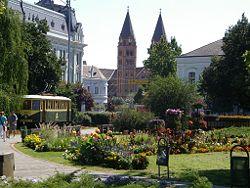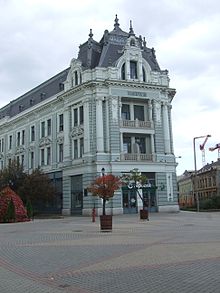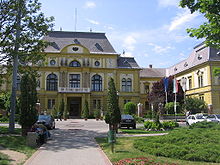- Nyíregyháza
-
Nyíregyháza City center 
Coat of armsLocation of Nyíregyháza Coordinates: 47°57′11″N 21°43′38″E / 47.95306°N 21.72713°ECoordinates: 47°57′11″N 21°43′38″E / 47.95306°N 21.72713°E Country  Hungary
HungaryCounty Szabolcs-Szatmár-Bereg Area - Total 274.46 km2 (106 sq mi) Population (2011) - Total 117,852 
- Density 425.92/km2 (1,103.1/sq mi) Time zone CET (UTC+1) - Summer (DST) CEST (UTC+2) Postal code 4400 Area code(s) 42 Nyíregyháza (Hungarian pronunciation: [ɲiːrɛɟhaːzɒ] (
 listen)) is a city in North-east Hungary and the county capital of Szabolcs-Szatmár-Bereg. With a population of 117,000 it is the seventh-largest city in Hungary and is one of the leading cities of Northern Hungary and of the northern part of the Great Hungarian Plain (Alföld). Its dynamic and spectacular development has been incessant since the 18th century, being the economical and cultural center of the region. Its zoo exhibiting more than 300 species including real rarities is recognized throughout Europe.
listen)) is a city in North-east Hungary and the county capital of Szabolcs-Szatmár-Bereg. With a population of 117,000 it is the seventh-largest city in Hungary and is one of the leading cities of Northern Hungary and of the northern part of the Great Hungarian Plain (Alföld). Its dynamic and spectacular development has been incessant since the 18th century, being the economical and cultural center of the region. Its zoo exhibiting more than 300 species including real rarities is recognized throughout Europe.Contents
Geography
Nyíregyháza is located in Szabolcs-Szatmár-Bereg county in the northern Plain region (Szabolcs-Szatmár-Bereg county, Hajdú-Bihar county, Jász-Nagykun-Szolnok county). It is the most important city of North Hungary, in all aspects of the center of the region. It is located in the center of Nyírség, as an agricultural town. The boundaries of the city are often understood as a very broad frame, because generally the near boondocks are listed here. It is located at the intersections of routes 4, 41, 36 and 38, therefore the city is easy to approach. The way to Sub-Carpathia and Transylvania is inevitable without passing the city.
History
The first written notes of Nyíregyháza date back in 1209, although it was called only Nyír (meaning "birch"). A source from 1326 mentions that by then the city already had a church church, hence the second part of the name, "egyház" (meaning "church"). In the middle of the 15th century the town had cc. 400 inhabitants. In the 16th century, during the Turkish occupation of Hungary Nyíregyháza became deserted, and was resettled only in the 1630s – 1640s.
After the War of Independence led by Prince Francis Rákóczi II, the population of the town increased. Most of the new settlers were Slovaks from the area of Békéscsaba. In 1786 Nyíregyháza was granted the right to hold four market days a year, by this time the town was the biggest town of the county with 7,500 inhabitants. In the early 19th century Nyíregyháza was wealthy enough to become free from her feudal lords, the families Dessewffy and Károlyi. During these prosperous years the town got a new town hall, a hospital, several schools and a restaurant by the nearby lake Sóstó ("salty lake").
The inhabitants of the town took an active part in the revolution and war of independence in 1848-49, and after the suppression of the revolution several citizens were imprisoned, among them the mayor, Márton Hatzel.
In the second half of the 19th century Nyíregyháza became more and more urbanized and in 1876 the town became the county seat of Szabolcs county (which is now part of the larger integrated county Szabolcs-Szatmár-Bereg). In 1858 the railroad line reached Nyíregyháza, several new buildings were built, including a telegraph office, the main post office and the theater. In 1911 the construction of tramways was finished.
After the many trials and tribulations of World War I Nyíregyháza was under Romanian occupation for ten months. Between the two world wars the city celebrated the 100th anniversary of becoming free from her feudal landowners.
During World War II more than 6,000 of the city's Jewish inhabitants were deported, and another 2,000 citizens were sent to Russian labor camps (colloquially called malenky robot). Several buildings were destroyed, too, including the Status Quo Synagogue, whose front wall has been preserved and it is in Nyíregyháza's Jewish Cemetery now.[1]
From the 1960s the city grew and developed quickly. Today, Nyíregyháza is one of the most prosperous cities of Hungary, being both an educational center and a popular tourist destination.
Population
Historical populations Year Pop. ±% 1870 13,015 — 1890 18,996 +46.0% 1900 28,073 +47.8% 1910 33,444 +19.1% 1920 38,751 +15.9% 1930 46,522 +20.1% 1941 53,917 +15.9% 1949 48,382 −10.3% 1960 56,834 +17.5% 1970 75,245 +32.4% 1980 108,235 +43.8% 1990 114,152 +5.5% 2000 112,419 −1.5% 2010 117,832 +4.8% 2011 117,852 +0.0% Tourist sights
Nyíregyháza also has several museums and exhibitions, showing the city's rich cultural heritage.
- Collection of the International Medallion Art and Small Sculpture Creative Community of Nyíregyháza-Sóstó – periodic exhibitions of works of contemporary artists
International relations
See also: List of twin towns and sister cities in HungaryTwin towns — Sister cities
Nyíregyháza is twinned with :
Broadcasting
Near Nyíregyháza, at47°56′12.17″N 21°45′28.35″E / 47.9367139°N 21.757875°E, there is the oldest radio mast in Hungary built in 1925. It is a 115 metres tall guyed mast radiator used for broadcasting on 1251 kHz, which was built in 1925.
Notes
- ^ Grand Rabbi Joseph Leifer of Nyíregyháza is buried in the cemetery. He was the son of the world-renowned Rabbi, Rabbi Mordachai of Nadvorna, and he settled in Nyíregyháza after World War I where he attracted a large following. His grave site is visited annually by thousands of Hasidim.
- ^ "Serwis informacyjny UM Rzeszów - Informacja o współpracy Rzeszowa z miastami partnerskimi". www.rzeszow.pl. http://www.rzeszow.pl/wspolpraca-miedzynarodowa/informacja-o-wspolpracy-rzeszowa-z-miastami-partnerskimi/668,informacja-o-wsp-lpracy-rzeszowa-z-miastami-partnerskimi.html. Retrieved 2010-02-02.[dead link]
- ^ "TABEL privind LOCALITÃŢILE ÎNFRĂŢITE cu localităţile din judeţul Satu Mare" (in Romanian). www.prefecturasatumare.ro. http://www.prefecturasatumare.ro/santoma/infratiri%20satu%20mare.htm. Retrieved 2009-06-27.
- ^ "Офіційний сайт міста Івано-Франківська" (in Ukrainian). mvk.if.ua. http://www.mvk.if.ua/news/4114/. Retrieved 7 March 2010.
Notable residents
- Ibolya Oláh - singer
Further reading
External links
- Nyíregyháza travel guide from Wikitravel
- Restaurant, bar, pub, daily menu & gastro guide from Nyíregyháza (Hungarian)
- Official site (English)
- Sóstó Thermal Bath (Hungarian)
- Sóstó Zoo
- Nyíregyházi Hírportál - hírek - news (Hungarian)
- A portal site (Hungarian)
- Index-Kelet - local news (Hungarian)
- Happy Art Festival site in English
- Bronze Age settlement and a former Sarmatian burial ground discovered in Nyíregyháza
Counties of Hungary Counties Bács-Kiskun · Baranya · Békés · Borsod-Abaúj-Zemplén · Csongrád · Fejér · Győr-Moson-Sopron · Hajdú-Bihar · Heves · Jász-Nagykun-Szolnok · Komárom-Esztergom · Nógrád · Pest · Somogy · Szabolcs-Szatmár-Bereg · Tolna · Vas · Veszprém · Zala
Urban counties Békéscsaba · Budapest (capital) · Debrecen · Dunaújváros · Eger · Érd · Győr · Hódmezővásárhely · Kaposvár · Kecskemét · Miskolc · Nagykanizsa · Nyíregyháza · Pécs · Salgótarján · Sopron · Szeged · Székesfehérvár · Szekszárd · Szolnok · Szombathely · Tatabánya · Veszprém · ZalaegerszegCategories:- Articles to be expanded with sources
- Nyíregyháza
- County seats in Hungary
- Populated places in Szabolcs-Szatmár-Bereg county
Wikimedia Foundation. 2010.






